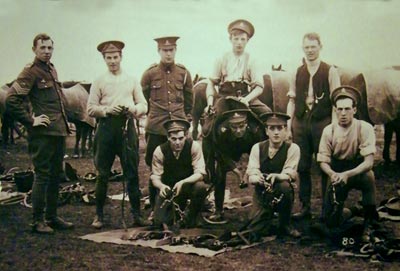Private
 |
| Remount Camp soldiers cleaning tack. |
Walter Cope
Aged 40
1915
WO 363 - First World War
Service Records 'Burnt Documents'
Service Number:
TR/4/146041
Regiment & Unit/Ship
Regiment Army Service Corps
Unit / Battalion Remount Depot
Date of Death
October, 1922.
Aged 48
Buried or commemorated at
Broadwas Church
on 25th October 1922.
Rector, Joseph Bowstead Wilson.
Country of Service
United Kingdom
Additional Info
Son of Mr. and Mrs. John and Emma Cope
Family history
John Cope married Emma Hooper in June qtr. 1865, Martley district. There son was Walter Cope, born 1875.
On the 27th September 1900, Walter Cope married Elizabeth Holmes, at Broadwas Church.
In 1901 Walter Cope [aged 25, born in Alfrick] was living with his wife Elizabeth [aged 26, born in Broadwas] in Stone Ley,
Broadwas, Worcestershire, and his Occupation was 'Waggoner on Farm"
In 1911 they were living at, Brickyard Cottage, Martley and had a son, William John Cope, and a daughter
Edith May Cope.
On the 4th November 1915, Walter Cope signed up in, E Squadron at, the Remount Depot, Romsey, Hants.
His address given was, Tinkers Cross, Broadwas, Worcestershire, occupation, Carter. His wife was Elizabeth Cope, and
their children were, William John Cope, born 31st December 1904, at Woodbine Cottage, Wichenford,
and Edith May Cope, born 18th April, 1909, at Lawn Cottage, Martley.
On 2nd November 1917, Walter received his first 'Good Conduct Badge'
Good conduct "badges", in the army, were inverted chevrons worn on the lower left sleeve.
Only soldiers with the rank of corporal or below were entitled to wear the good conduct chevrons.
One chevron represented 2 years "good" service.
Walter was discharged, no longer fit for War Service Para 392 [XVI] K. R. 18th October 1918.
HISTORY INFORMATION
The Romsey Remount Camp was of strategic importance during World War I being one the two closest camps to the
docks at Southampton. The camp was a holding and training point for horses going to the front; it was also a place
where returnees could be nurtured back to health and sent back to the front. Its presence had a marked impact on
the local landscape and economy around Romsey.
Romsey camp received its first horses – just 20 – in March 1915. By the end of the war it had processed about 120,000,
around 10% of the animals acquired by the Remount Service. Its primary function was to train horses and mules for war
service, and by 1916 there were over 2,000 men stationed at this camp. They were divided into squadrons, with each
containing 'rough riders' to break in young horses, a farrier sergeant, shoeing smiths and saddlers.
As the war progressed it became increasingly difficult to find suitable men for these trades. Many men previously
considered to be too old or unfit were medically upgraded as 'fit to fight at the front'. Members of the Woman's Land
Army were bought in to work in their place. The recruitment and organisation of women who could be enrolled for work,
and particularly for situations like this, became of national importance.
There were often more than 4,000 horses and mules in the care of the squadrons at Romsey. Sometimes as many
as 830 horses might be received in a day. The general length of stay of each horse varied, but was usually between
one and four months, either for training or recuperation. Romsey had a large isolation hospital, where sick horses
could receive the best veterinary care.
|
|
|
Return
©peh


